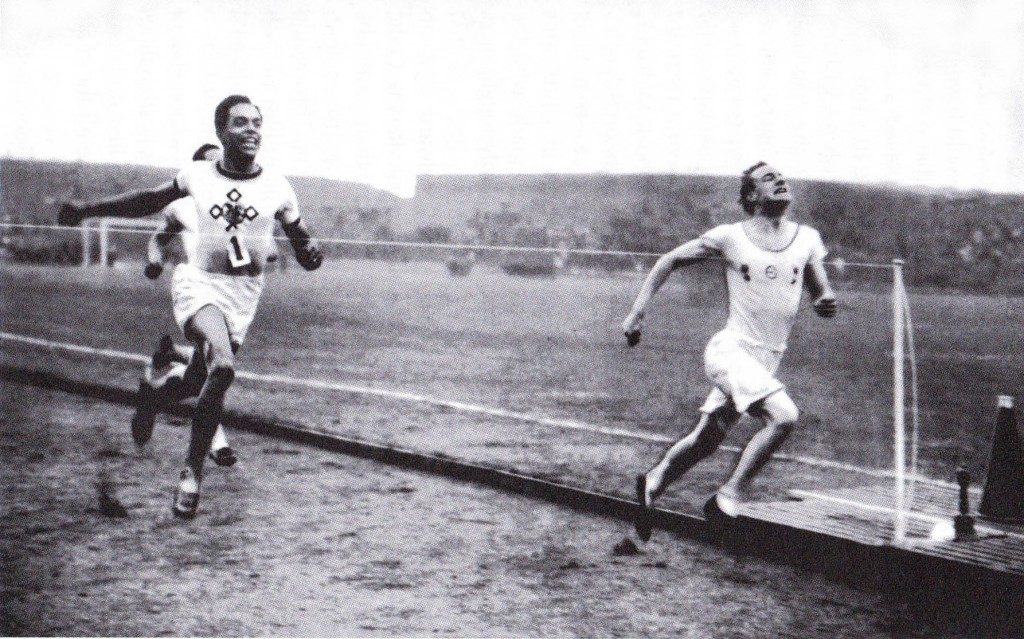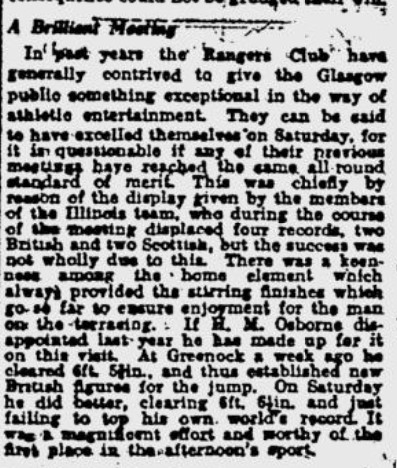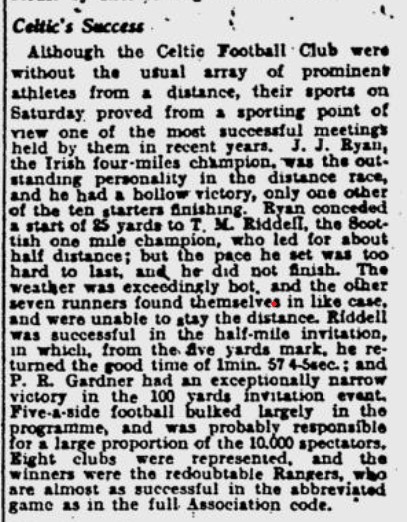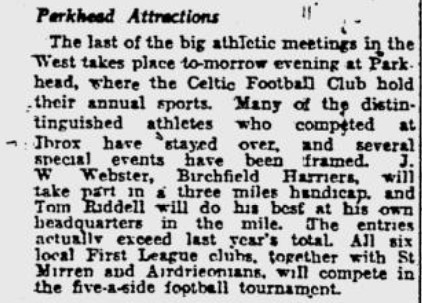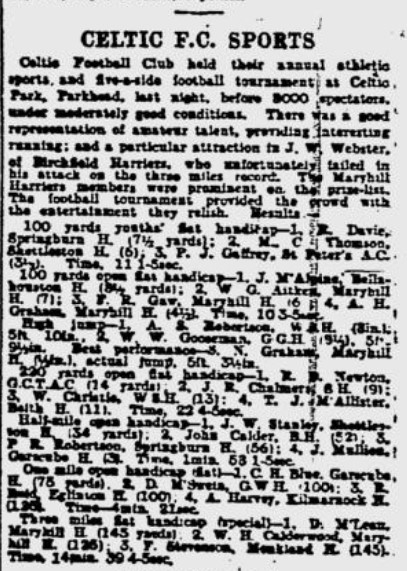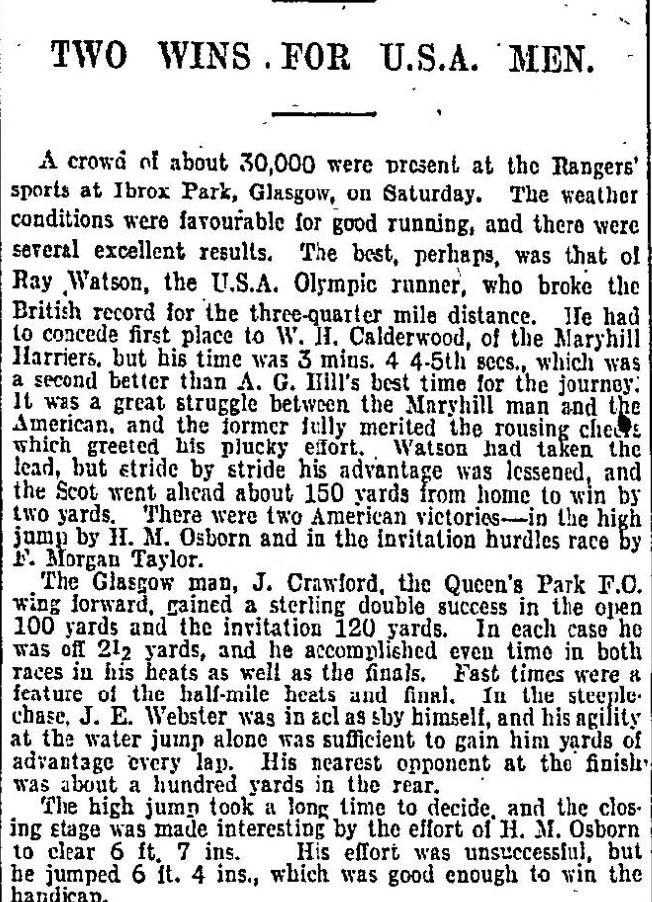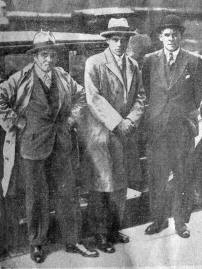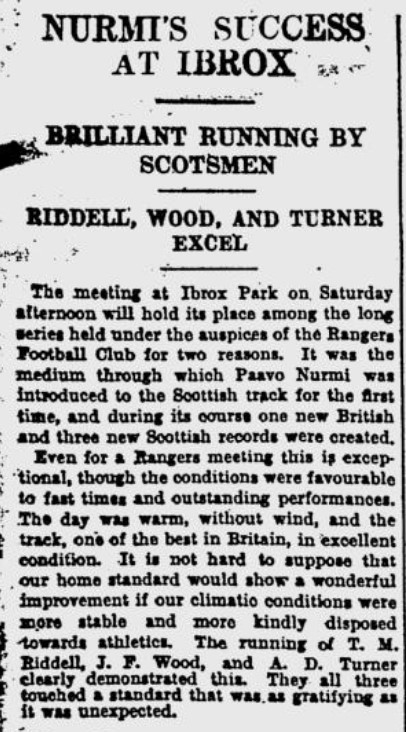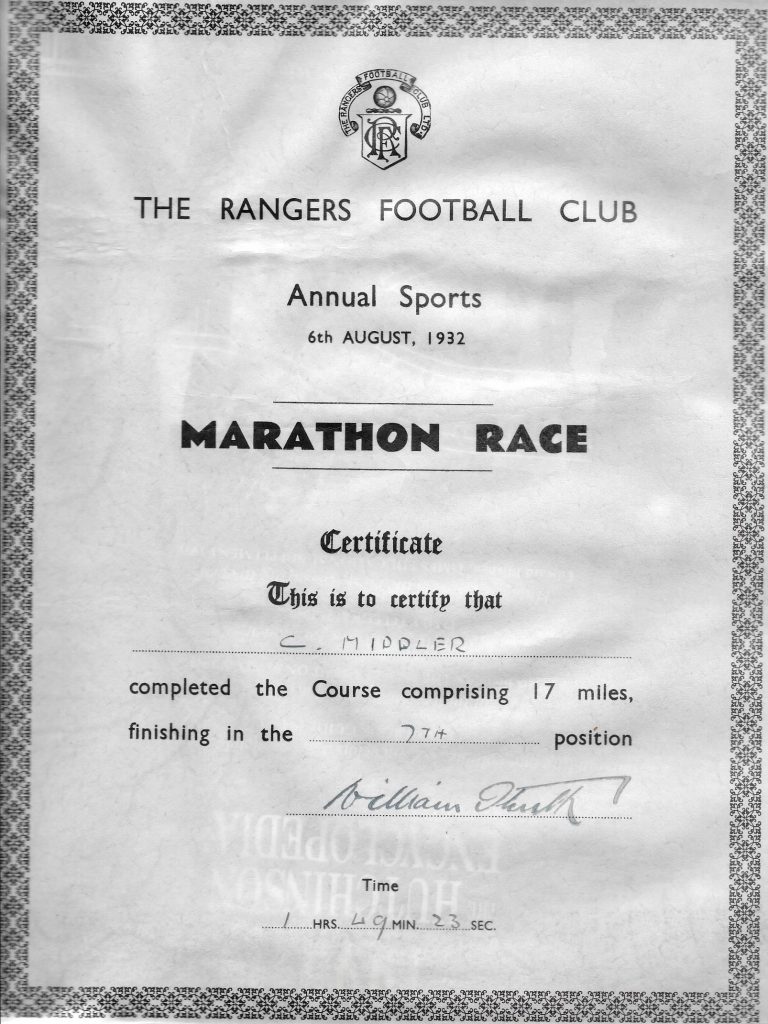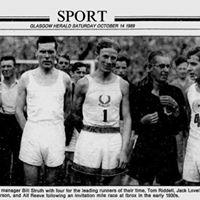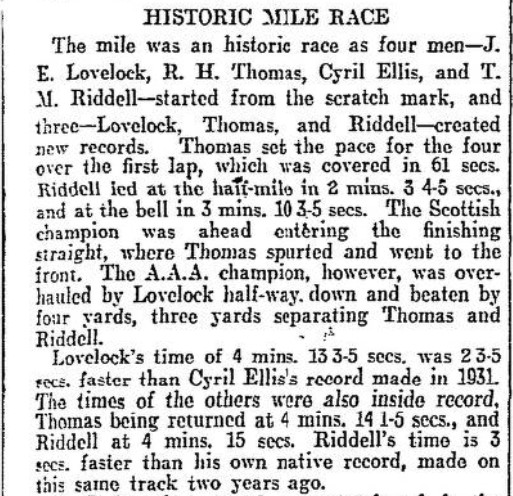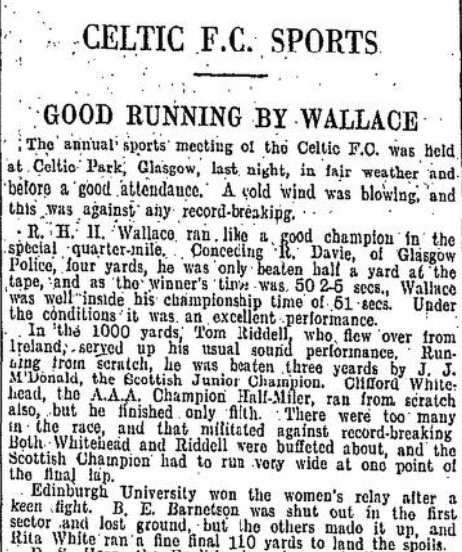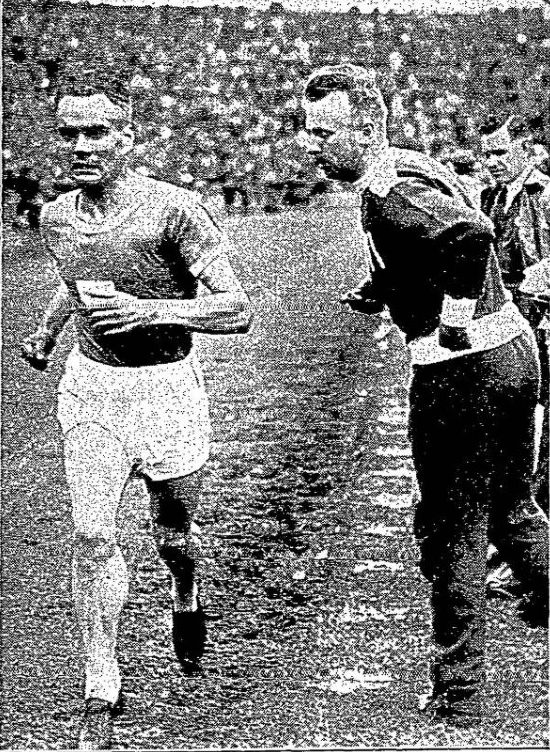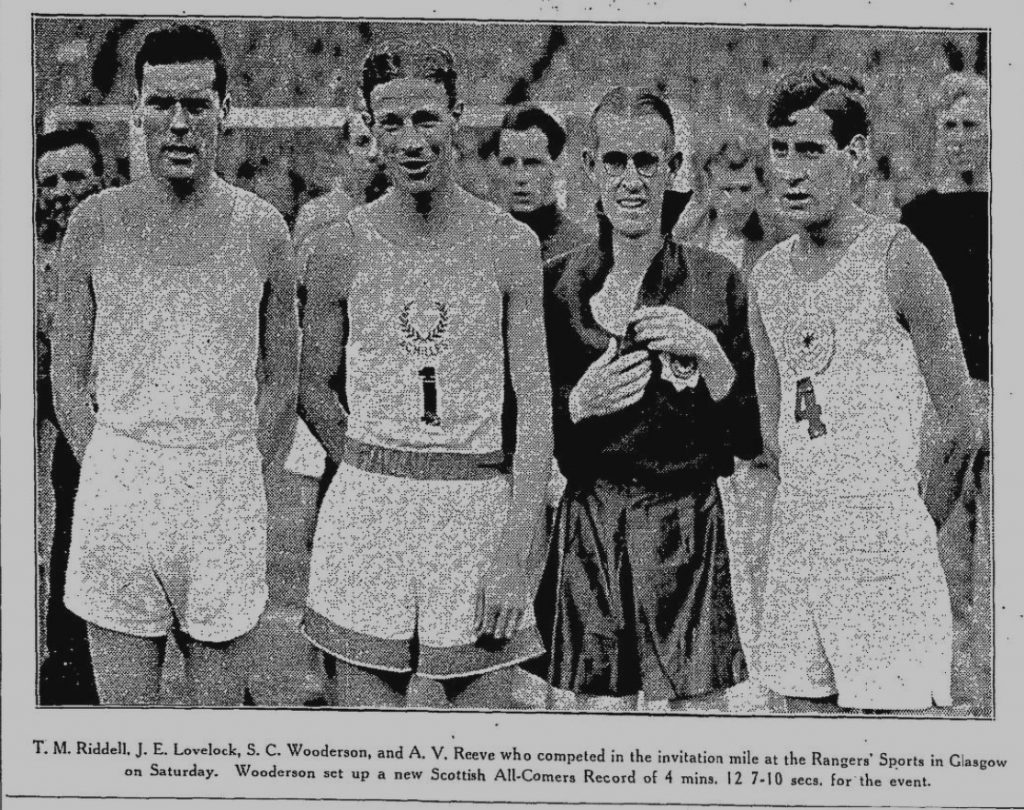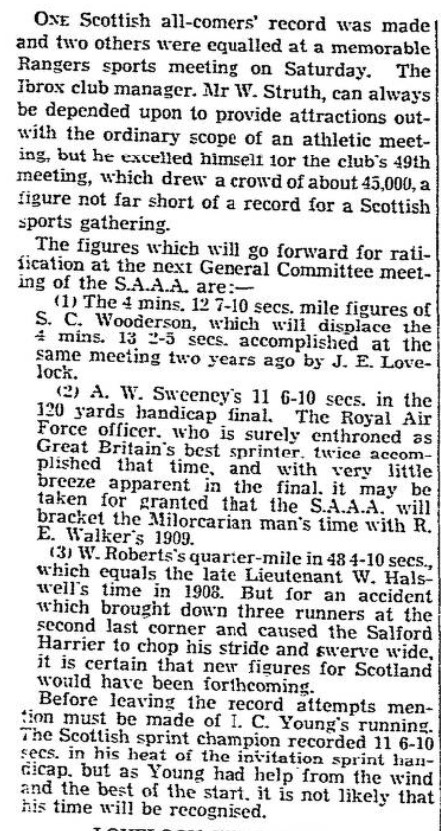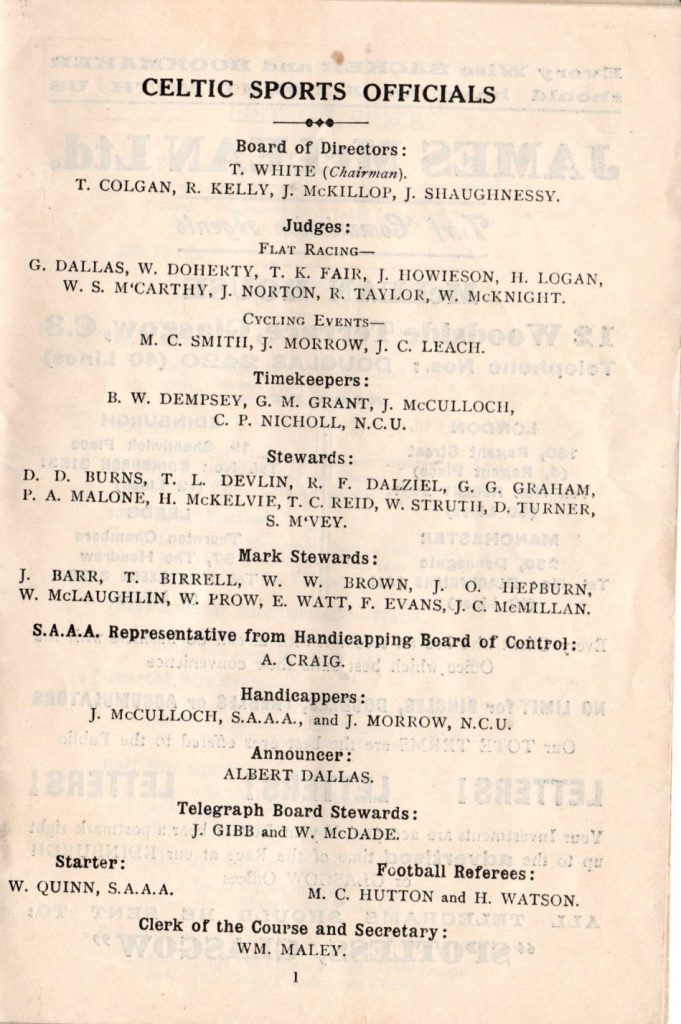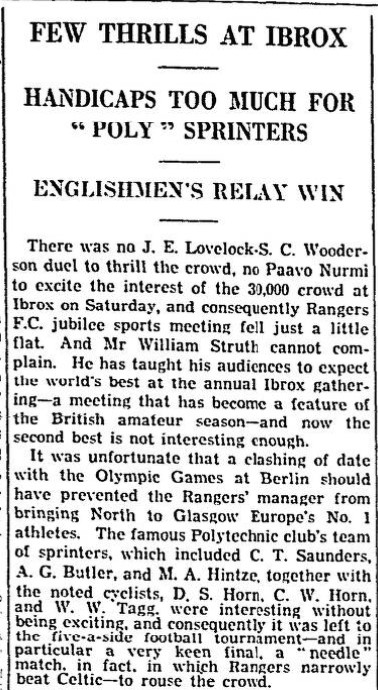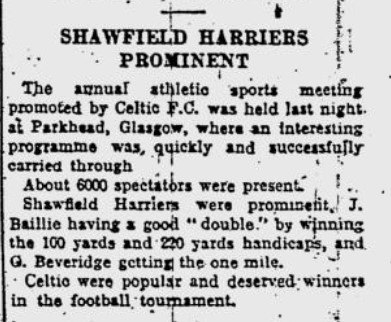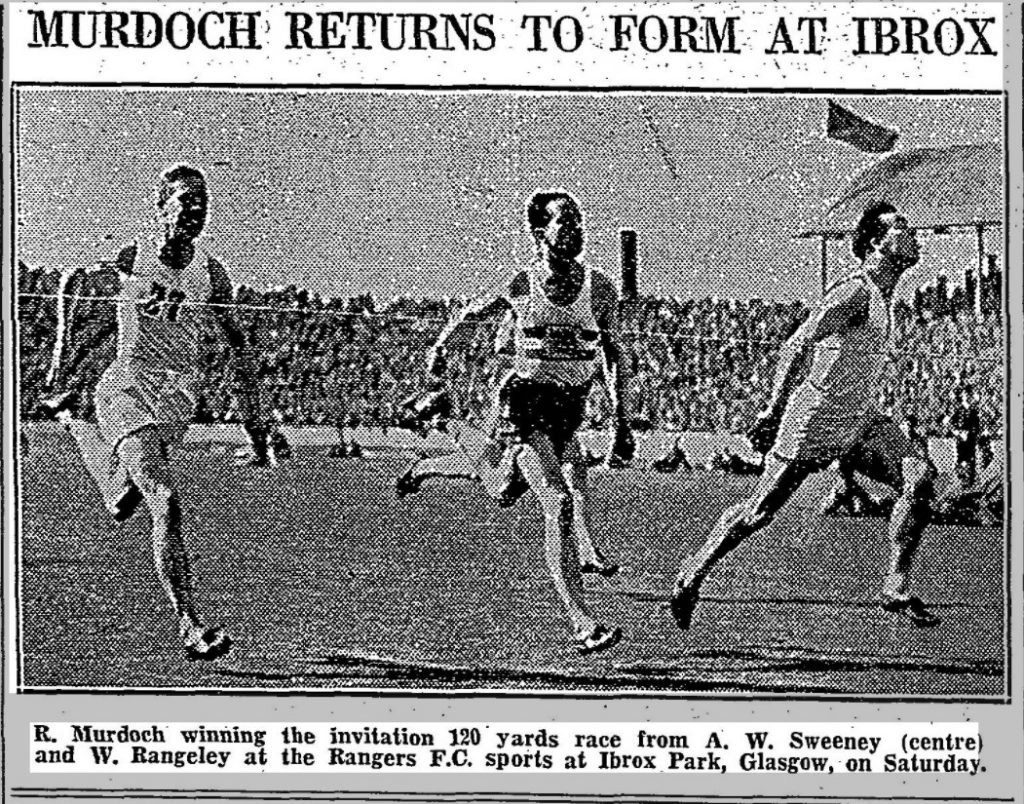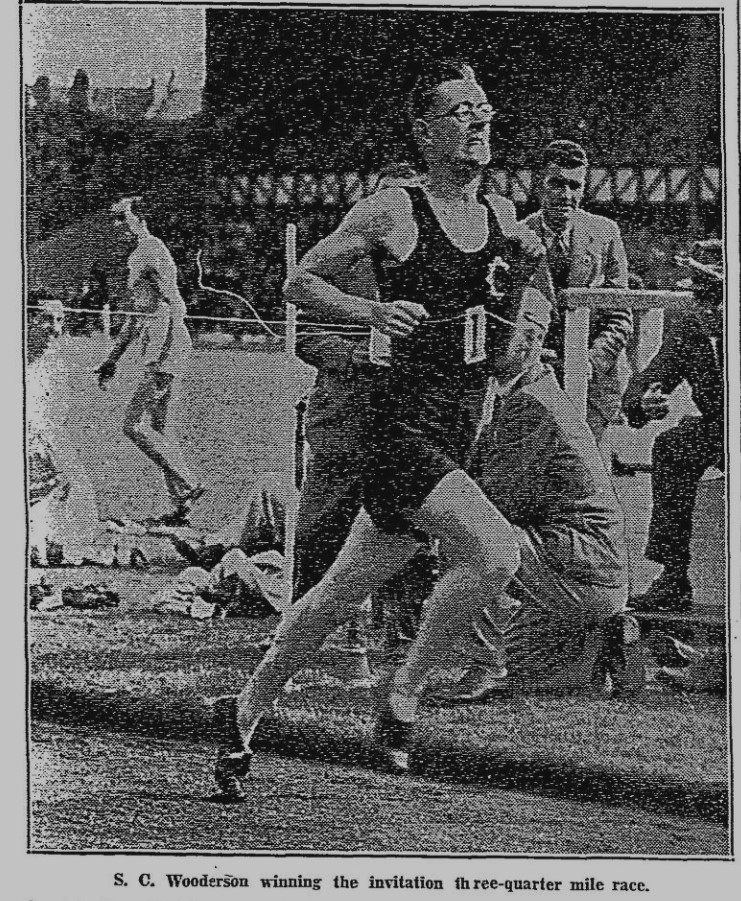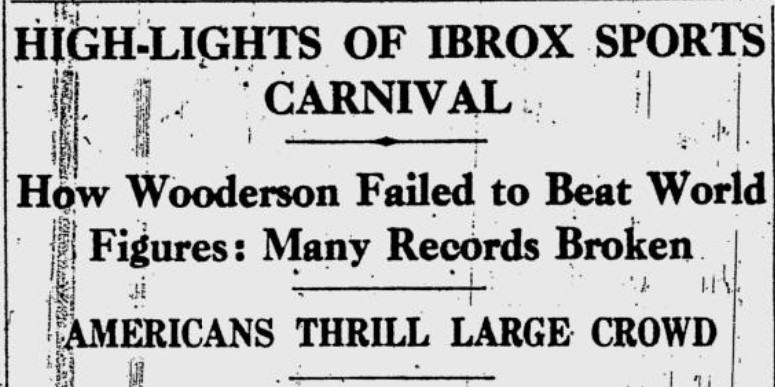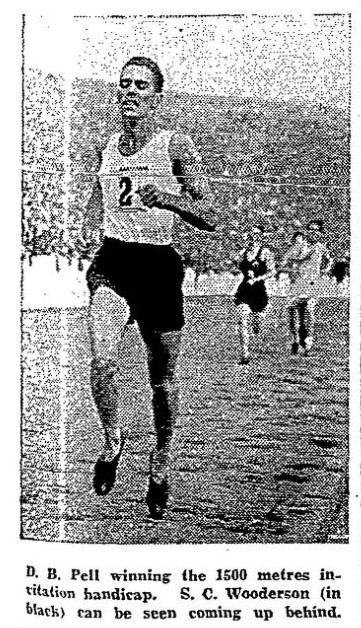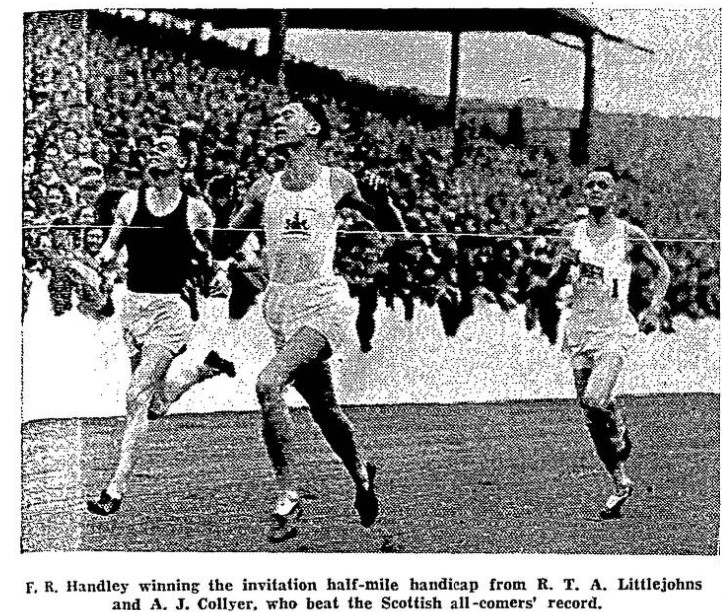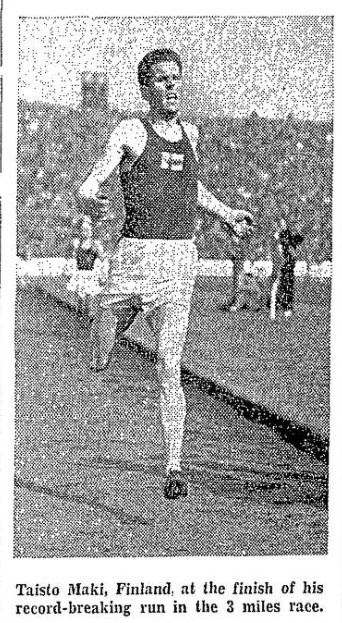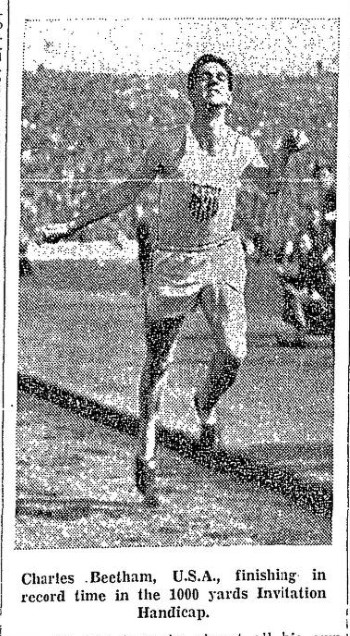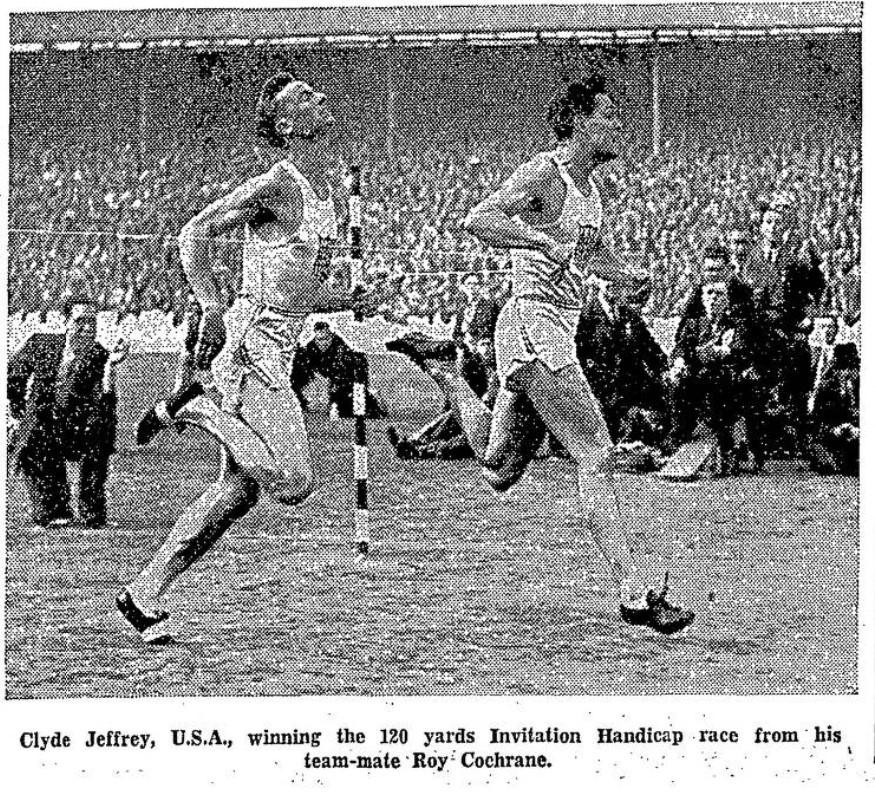Eric Liddell winning the 220 yards at Celtic Sports in 1922
When the 1920’s started Maley was the elder statesman who had been around athletics since 1896, been a sports promoter since 1890 and was President of the SAAA as well as being a successful football team manager. Struth was the coming man: a professional runner up to the age of 32, trainer with Hearts and then with Clyde from 1908 until he joined the Rangers in 1914 and promoter in his own right from 1920. Both had been officials in meetings – Maley as judge and Clerk of the Course, Struth as starter, a post he must have held at the Clyde Sports simply because he would not have been given the job in his first season at Ibrox had he not been experienced, and Clerk of the Course. Both clubs had kept the sports going during the war, albeith on a much reduced basis – there were events confined to military men – a stretcher race, a 10 mile marathon confined to the army, etc – and a lot of fund raising for the war effort was done with fairly generous donations made by the clubs. The first meetings after the war were held in 1918
In 1920 both were well supported by spectators with 30,000 estimated to be at the Celtic meeting, and by the runners with 22 heats of the 100m and 19 of the furlong; while at Ibrox the previous week there were 40,000 in attendance, and there were new Scottish records by McPhee (Scottish native record) and AG Hill (Scottish all-comers’ record) in the invitation 1000 yards. Both meetings were very successful but there was an almost entirely domestic field in the events. If anything, Rangers had a slight advantage in the appearance of two or three good English runners with AG Hill the pick of the crop. And so it continued for the first few years of the decade with respectable attendances (promoters in the 21st century would give their eye teeth for such numbers) but, quality domestic fields containing a few Englishmen, rarely anyone from abroad. ie:
In 1921, Randgers Sports: Attendance 15,000, top athletes Eric Liddell, Duncan McPhee, AG Hill and American high jumper B Howard Baker; Celtic Sports: Attendance 18,000, Eric Liddell, D McPhee, AG Hill.
1922, Rangers Sports: 30, 000, R McGrath (Manchester, D McPhee (against another 141 runners in the mile); Celtic Sports 15,000 (Very wet day) E Liddell, D McPhee.
1923, Rangers Sports: 40,000 WH Calderwood, D McPhee (T Riddell of Glasgow High School almost won Mile); Celtic Sports, 16,000J McIntyre, C Blewitt, D McL Wright.
But 1924 was different for two reasons. First, it was Olympic year and they were held in Paris between 5th July and 27th July. Close to Scotland and just after the Games, with expenses to and from Scotland paid, there was every incentive to come along. Mr Struth must have been convincing because, well see the heading from the Glasgow Herald:
The international stars lived up to their billing with good performances all round. JV Schols (USA) won the invitation 120 yards, SJM Atkinson (South Africa) won the 120 yards hurdle race, Eric Liddell won the 440 yards and C Griffiths (Wales) won the 880 yards.
Second, the Glasgow Herald was not as complementary to Celtic as it had been in 1923. Let me quote from the ‘Glasgow Herald’ of August 11th 1924. “In former years the second Saturday of August saw the last of the big amateur athletic gatherings in Scotland. Rangers Football Club occupied the first Saturday, Celtic the second; but this year there has been a change, the East-End club giving up their sports in favour of a five-a-side football tournament. The estimated attendance at Parkhead on Saturday, 15,000, compares badly with the 40,000 or 50,000 that assembled at Ibrox a week previously, but the Rangers offered attractions of an almost unprecedented nature, the competitors including some of the most famous competitors from the Olympic Games in Paris. Had Celtic followed suit they might have had an equal attendance, but on this occasion they chose to follow a more prudent but less heroic course. The performances of the Olympic giants at Ibrox were not impressive, and it might not have happened that the glamour had gone off, and that the Parkhead club might have been saddled with the heavy expense of a first class meeting and missed the reward. Still, the decision to abandon an old-established meeting, and one that has always been held in the highest repute, is to be regretted, and all interested in athletics in Scotland and hope that the meeting will be revived next year.” If I read that properly, then the reporter insinuates that the Celtic management were afraid of making a big loss. I would not have thought that such was the Maley style. It might as easily have been the start of the Scottish football scene exactly seven days later. Preparation for the opening matches could more easily be included in a football tournament a week in advance than in an open and invitation sports meeting. Coming when it did, the Celtic Sports would eventually suffer from the situation.
However the year passed and Struth built upon the previous year and the Glasgow Herald said
The results were all of a very high standard: Ray Dodge (USA) was timed at 2 min 13.6 for 1000 yards was a new Scottish all-comers record but also a new British record, the previous British best having been 2:14.5. This had been a really close race between Dodge and Griffiths with Dodge just getting the verdict. ‘Existing figures were also beaten in the hurdles and pole jump. On a day of brilliant weather there was a crowd of approximately 35,000. The restored Celtic meeting was held the following week and the report read as follows.
Rangers again had a very large crowd the following year when 30,000 went along to see a meeting consisting mainly of home Scots with several very good English athletes and a single athlete from abroad in the form of a French high jumper. No records but very good sport. However the football season started on the second Saturday of the month. What would Celtic do? Would the meeting be abandoned altogether in view of the fact that the opening matches had been brought back a week by the SFA? The answer was that it would not be cancelled. It was a difficult decision to take since almost every Saturday in the summer months was a traditional date for some meeting or another – many by other football clubs, so for 1925 the meeting was held on the Tuesday after the Rangers Sports. Why then? Read the following:
The report on the meeting on Wednesday in the Glasgow Herald read:
Successful by present day standards but the relatively small crowd for a meeting that included a five-a-side tournament four days before the season tells a tale. Unless they could find a regular Saturday slot for the meeting, the Celtic Sports were doomed. Incidentally the football final was won by Rangers (Cunningham, McKay, Craig, Archibald and Morton) with 2 goals over Celtic (W McStay, J McStay, Thomson, McGrory and McLean) who had nil.
What happened in 1927 was an attempt to fins another Saturday for their meeting but there were problems. Their range of alternative dates was circumscribed (a) by all the other regular meetings, and (b) by the lengthening football season – ending later and starting earlier. Queen’s Park FC Sports were on the first week in June, the Glasgow Police on the third week in June, SAAA Championships a week later, Greenock Glenpark were on the last week in July, Rangers on the first week in August and so on. It had to be a move back and the second Saturday in July seemed a good choice but – in 1927 it fell on the same day as the English championships. Nevertheless it went ahead on 27th July although it was not the first big meeting at Parkhead that year – the SAAA Championships had been held there in June. The Glasgow Herald began its report – “There was a time in the past when Celtic Football Club’s meetings scintillated with most of the stars that shone in the athletic firmament, but this year the bringing forward of the gathering, due to the encroaching of the football season and its consequent coincidence with the AAA championships compelled the management to rely entirely on home talent. Frankly the absence of the imported element did not affect the afternoon’s sport, so varied and well balanced was the programme. ” Maley knew his business and continued to host the Celtic Sports every year despite the difficulties. . In contrast the Rangers match was held before a crowd of 35,000 and was held to be a tremendous success. Struth had managed to persuade parties from Polytechnic Harriers and the Achilles Club to come along. Notables included Douglas Lowe and Lord Burghley – names which would draw crowds on their own – but the top athlete on the day was JWJ Rinkel of the Achilles Club who won the invitation 120 yards handicap from scratch as well as the open 220 yards. Other events won by the southerners were the invitation 440 yards hurdles by Lord Burghley (also second in the 129 yards hurdles), JE Webster the eight laps steeplechase, C Ellis the first class open mile (there were two open miles because of the numbers entered – the best runners being in the first class race), and JE London the high jump.
Problems arose on the new date almost immediately – the triangular international with England and Ireland which had previously been held on the last Saturday in June moved to the second Saturday in July in 1929, and was still there in 1930. The reason is understandable. It was the week after the SAAA Championships. To compete in two such high profile events in successive weeks was not ideal and they were moved. This left Celtic with another headache. Almost every Saturday in June and July was taken up with one event or another, some of the major events are listed above but other football clubs such as Partick Thistle and Falkirk had their own dates, and there were meetings all over the country from Golspie to Lockerbi via Aberfeldy, Beith and Catrine.
Rangers Sports in 1928 were another success as is shown by the brief report in the Scotsman on the following Monday.
Americans as well as Englishmen – high jumper Osborn was one of the Americans from Illinois in his second year at Rangers Sports. It was again an Olympic year and fixtures were all over the place trying to avoid the Olympic period. Celtic seem to have found the task impossible and the next Celtic Sports appeared in the papers in 1930. Mreanwhile the Rangers Sports of 1929 had an estimated attendance of about 20,000 who witnessed some very good athletics from some excellent English athletes including the Olympic sprinter Jack London and the One Mile (medley) Relay was won by Birchfield Harriers from Polytechnic Harriers.
The Rangers Sports of 1930 were held before a crowd of 20,000 and the best performance was that of Tom Riddell who beat John McGough’s Scottish record for the mile with his time of 4:19.6 in the special mile which he won from R Thomson of Bellahouston Harriers. It was an entirely domestic field with only a few Englishmen who turned in undistinguished performances. Celtic held their sports the following Tuesday before a moderate crowd. The Glasgow Herald report below indicates that it was a good sprts meeting but virtually every race wasbetween domestic athletes althouth there were a couple of Irish competitors also present.
In contrast, the Ibrox meeting of 1931 showed Struth at his finest. In the photograph above he is shown welcoming Paavo Nurmi an d his manager to Glasgow for the Rangers Sports of 1931. Possibly the most famous athlete in the world, the Finn was a great capture for the Rangers Sports and Struth had his picture in the papers on his arrival, during the meeting and made sure that he himself, as representative of the Rangers FC, was in them. Nurmi wasn’t the only star athlete on display but he was the name on the publicity. The Herald on the following Monday said –
He ran in two races, the two miles and the four miles, before a crowd of 45,000 spectators who saw during the afternoon four records broken. Nurmi set an all-comers record of 19:20.4 for the four miles and Cyril Ellis of England set a record of 4:15.2 for the mile. .Tom Riddell set a native record for the mile of 4:15 and JF Wood set a native record for the four miles of 14:44.2. It was a total success by any measure – attendance, quality of athletics or just as entertainment. As for the Celtic, Despite the success of the 1930 meeting there was apparently no follow up meeting in 1931 – at least not on the three dates previously used by the club – second Saturday in July, second Saturday in August or second Tuesday in August.
In 1932, the triangular international was again on the second Saturday in July and the Tuesday in August which had previously been the club’s alternative date of choice saw most of the regular athletes (Bobby Graham, Walter Calderwood, etc) in action at the Springburn Harriers meeting at Helenvale. At Celtic Park, Celtic FC had their final trial before the opening of the football season the following Saturday. The Saturday before that saw the 46th Rangers Sports with a crowd of 23,000 or 25,000 depending on which paper you read. The conditions were all against good times as the Glasgow Herald tells us, but the performances were all of a good standard with the first three in the invitation 120 yards hurdles being R Murdoch, M Rousseau (Racing Club de France) and J Bell (Cliftonville Harriers) to maintain the international aspect of the meeting. It was only won by a yard but a relatively closer finish was the invitation 1000 yards where Calderwood won by only three yards from RE Clark of Plebeian Harriers. Wylie of Darlington won the three miles, and in the relay, Maryhill Harriers beat a French Select and Polytechnic Harriers by 18 yards. There was also a 17 miles road race in which England’s Ernie Harper was second to Donald Robertson with Wilson of Irvine third. There were even three handicap prizes as well as for the first three. A big day for the road runners. All finishers received a certificate, see below, which was another novelty and the certificates were treasured. Another successful day for Bill Struth’s organising committee. It was just a pity that the SFA had spoiled the Celtic meetings or the Glasgow (and Scottish) public would have had several wonderful meetings.
There was a reprise of the road race in 1933 but the headlines were not for the road men at all. Have a look at this from the ‘Glasgow Herald’
Mr Struth with another star or two at the Rangers Sports. This time it was Jack Lovelock from New Zealand who was the star draw – and unlike many other top names, he did not disappoint. He was not the only top notch athlete on parade that afternoon:
- TH Scrimshaw (Belgrave Harriers) broke the Scottish record for the half mile
- Don Finlay, AAA’s champion won the hurdles race ina hard fought battle with GUAC runner AS Kitchin
- Ernie Harper won the 17 miles road race from Dunky Wright and JF Wood who was running in his first ling road race
- GT Saunders (Poly Harriers) equalled the Scottish record when winning the invitation 100 yards.
But the race of the day had to be the Invitation One Mile in which four quality athletes from four countries – NZ, England, Wales and Scotland all started from the scratch mark.. The ‘Scotsman’ report on the race and the photograph from the same source-
The Celtic Sports had already been held – 10th July was the date and there was a good turnout on a windy afternoon at Parkhead. Riddell ran in an invitation 1000 yards race and there were several very good Scots competing with quality Englishmen. The report in the Scotsman read:
The Celtic meeting had been a good one, held during the west of Scotland holiday month of July while the Rangers had been an international meeting after all the holiday trips but while the atmosphere was still high and a tremendous success. It speaks highly of the desire of Celtic to hold an athletics sports that they should carry on in such difficult circumstances. Their problems had been accentuated by the SAAA changing the date of the international track match to the second Saturday in July which had looked as though it would be a good date for the club’s sports. The Football Association had brought back the season’s starting date causing the search to begin with, and then the SAAA had exacerbated it by moving their date forward. In 1934 the sports were held on Tuesday, 7th August and although the event was covered there was no report on the athletics – the entire report was devoted to the fact that a Celtic player called Crum (we were never told his Christian name by the ‘Glasgow Herald’) had his leg broken when he fell in a tackle by a Clyde player called McPhail during the first five-a-side match. Five paragraphs were devoted to the event. There were six races, two cycle races and a five-a-side tournament. The races were all domestic affairs with not a single big name or champion among them.
Laurie Lehtinen being give lap times by Borje Strandvall at Ibrox.
The Rangers Sports on the other hand were well covered by most of the quality Scottish papers with a big international cast for the spectators to feast their eyes on. The name on most lips was that of the Finn Lauri Lehtinen who set new Scottish figures for the three miles of 14:15.4. There were many Scottish names in the race which were or would become good runners in their own right. eg Alex Dow of Kirkcaldy and David Brooke of Garscube Harriers who would be a timekeeper at the 1970 Commonwealth Games and other major fixtures. The special quarter mile was a real battle between Borje Strandvall (Finland), JM Hucker (USA), R Boisset and K Stravisky (both France): they all ran from scratch but the race was won by C France (Bellahouston) who had been given 12 yards. The high jump was won by CA Scott (Cornell) and another American JM Curran (Princeton) was second in the open 220 yards. RF Hardy the American inter-collegiate champion entered three sprints but did not survive the heats. Boisset and Dondelinger (France) both qualified for the final of the open 220. It had been a really high class match with 13 open events, 4 invitation and a five-a-side tournament.
The picture below tells us all we need to know about the value of Maley’s Celtic Sports and Struth’s Rangers Sports to Scottish athletics when they were operating at their best. A Scot running on home soil with a New Zealander and two excellent English runners. The publlicity gained from running in front of a big crowd and the inspiration passed to the hundreds, literally hundreds of club runners, competing on the day. Any runner in the open mile, having seen these and others in the invitation mile must have been inspired to greater things and run better on the day. If you doubt the ‘hundreds of club runners, start with a not-uncommon twenty five heats of the 100 yards with eight men per heat and there are 200 men already, add in 140 plus in the Mile, again not unusual, and we are already up to 340 club runners. Athletics owed these two organisers a lot. Had the Celtic Sports been able to continue to the 1960’s as Rangers did, both sports would have been the better of it.
The meeting highlights are noted in this extract from the Scotsman of the following Monday – and manager Struth is given credit for the standard of the meeting:
The outstanding attraction was of course the invitation mile where Lovelock was well beaten and the race was won by Reeve (25 yards) from Riddell (35 yards) with Wooderson (scratch) third. In the 5-a-side competition, the Rangers side (Meiklejohn, Brown, Venters, Smith and Gillick) defeated Celtic (McGonagle, McMcDonald, Morrison, Buchan and Delaney) 2 – 1.
Was Willie Maley still involved in the organisation of the Celtic Sports? They were increasingly difficult to organise, problems were being created by both football and athletics governing bodies and the Rangers Sports were greatly enhanced in status. Had he delegated the athletics to another member of the organising committee? The answer comes in the programmes where the list of officials occupied a prominent position in the opening pages. The programme for 1935 lists them as –
There he was in the traditional place as Clerk of the Course. It was a full 24 page programme for the meeting on Tuesday, 6th August 1935. Just when you thought the event was on its last legs, an excellent meeting came up on Tuesday 6th August 1935. The headline read:
“NEW SCOTTISH RECORD AT CELTIC SPORTS:
R GRAHAM’S SUCCESS OVER THREE-QUARTER MILE.
The annual sports meeting of Celtic FC was held last night at Celtic Park, Glasgow, in fine weather conditions and before a moderate attendance. Some excellent sport was witnessed, and in the special invitation race over the three-quarter mile, R Graham set up a new Scottish record of 3 min 4 6-10th sec, this time being 1 6-10th sec faster than that set up by Tom Riddell at the Queen’s Park Sports three years ago. Graham ran from the scratch mark, instead of the 10 yards as originally intended in the handicap and he was accompanied by J Gifford and JP Laidlaw to both of whom he conceded 10 yards. He covered his first lap in 61 seconds, but took 63 4-10th for the second. In his final 300 yards however, he put in a great finish catching the leaders at the last bend went on to win by six yards from W Gunn. “ There were six races, three cycle events and a five-a-side.
1936 was a year when the Scotsman headline read “FEW THRILLS AT IBROX” before going on to explain.
That was the same story in most papers – “interesting but not exciting.” The Olympics were not just any Games, but it was 1936 with the ‘Gathering Clouds over Europe’ and Jesse Owens winning in Berlin and a lot of attention was focused in that direction. There was still a crowd of sizeable proportions (30,000) and interesting athletics. Celtic suffered likewise from the Olympics and also from a midweek evening date and coverage in both Glasgow Herald and Scotsman was scanty with almost identical content in their brief coverage. This is from the Herald
1937 was another very good year for the Rangers Sports with very good, if not magnificent, performances studded through the programme with many of the old favourites on view. The Scotsman photograph below is of one of these, and a Scotsman too.
“SC WOODERSON BREAKS BRITISH RECORD”. “BRILLIANT PERFORMANCE IN THREE-QUARTER MILE AT IBROX.” “THREE TENTH OUTSIDE WORLD RECORD FIGURES.” “ROBIN MURDOCH’S TRIUMPH” “WIND THWARTS WOODERSON OF FIRST WORLD RECORD.” These were just some of the headlines over the reports on the Rangers Sports in 1937. The pictures of Murdoch and Wooderson here are from the Scotsman on the following Monday. The result of the invitation Races were as follows.
Quarter Mile: 1. RTH Littlejohn (Edinburgh H, 15 yards); 2. W Roberts (Salford H, scr); 3. FF Wolff (London AC, 10 yards)
120 yards hurdles was 1. R Murdoch (Atalanta, 1 1/2 yards); 2. AW Sweeney (Milocarians, scr ); 3. W Rangely (Salford , 1 yard) 1.6 sec
Half Mile: 1. JW Alford (Roath H, 8 yards); 2. O Hoel (Field Events Club, 8); 3. AJ Collyer (Watford H, scr). 1 min 54.2
Three Quarter Mile was: 1. SC Wooderson (scr); 2. RH Thomas (RAF and Surrey AC, 10 yards); 3. RC Eden (Watford H, 12 yards). 3 min 0.9 sec. Scottish and British all-comers record.
It was a good well attended meeting where, by universal opinion, the wind deprived Wooderson of a world record.
In 1937 and 1938, team trials seemed to be the order of the day for the club in the week leading up to the start of the season, and there were no notes of any Celtic FC Annual Sports on the usual dates available to them in the past. After the SFA brought the start of their season back a week, the search for a new date was thwarted again and again by facts outwith their control and it was a real pity – and a loss to all sportsmen in the country when the Celtic Sports came to an end.
The Rangers event continued – why should it not as long as their date remained available? The Glasgow Herald headline for 1938 is below.
In front of nearly 70, 000 spectators – yes, SEVENTY THOUSAND – and in ideal conditions, what was one of Struth’s best ever meetings took place. Four records were broken, including a British and Scottish all-comers record; athletes from Scotland, England, Wales, South Africa, America and Canada were competing in invitation events and hundreds of Scots club athletes took part in 10 track and field events (including for women and Youths) and a marathon, plus two cycle races and a five-a-side competition in which Partick Thistle defeated Celtic in the Final.
This is not the place for a full report on the meeting, that would take a page in its own right, but the results of the invitation events can be noted:
Half Mile: 1. FR Handley (Salford, 6); 2. RTH Littlejohn (Edinburgh H, 12); 3. AJ Collyer (Watford). Collyer’s time of 1:52.8 was a Scottish All-Comers record)
Quarter Mile: W Fritz (Canada scr); 2. JW Loaring (Canada 6); 3. CF Campbell (Springburn 1 7) 48 sec
1500m: 1. DP Bell (Herne Hill, 30); 2. SC Wooderson (Blackheath, scr); 3. AV Reeve (Polytechnic, 42). 3:46.9. Wooderson’s time was 3:49.0
120 yards: P Walker (USA scr); 2. JM Cole (Glasgow Police, 5 1/2); 3. AA Clarke (Dumbarton 5 1/2) 11.7 sec
120 yards hurdles: 1 D Finlay (RAF 2. J Patterson (USA); 3. A Tolmach (USA) 14.7 sec. A Scottish all-comers record..
Pole Vault: 1. DM Hastie (Hillhead HS, 3′ 9″); 2. H Hood (Edinburgh Police, 2′ 6″); 14′ 7″ Cornelius Warmerdam (USA) vaulted 14′ 3″ to establish British and Scottish all-comers records.
The marathon race which had started in Gourock was won by TF Lalande (South Africa) in 2 hours 46 minutes 58 sec , from TA Strachan (Glasgow YMCA) who ran 2:54:12.
It really was a wonderful meeting and one worth reading about in detail when you are browsing old newspapers. The picture below is from the Scotsman.
…
The 1939 Sports were equally good with star athletes from many countries taking part – Scots, English and of course Americans were there , they were joined by quality Finnish and South African runners. Two new British records, four invitation events, eleven track and field events, a marathon race, two cycle races and a five-a-side competition. And a crowd of at least 60,000.
Again it was a Finnish distance runner who excited the crowd most. Tasto Maki ran in the Three Miles and ‘reeled off lap after lap with effortless ease.’ He had to make all his own pace and although he didn’t catch Bingham, the handicap winner he was 4:37.4 at the mile, 9:26 for two miles and 14:03.4 for the three miles. The American Charles Beetham was one of three men on the scratch mark for the 1000 yards, the others being the star American Blaine Rideout and AJ Collyer (England). Collyer took them through the quarter in 57 seconds, at the half mile Beetham was just inside 1:57 and at the finish he was timed at 2 minutes 11 seconds.
.The results of the invitation events were as follows.
120 yards handicap: 1. Clyde Jeffrey (USA); R Cochran (USAS, 4); 3. JM Bone (Bellahouston, 6 1/2) 11.8 seconds
440 yards: 1. R McGregor (Maryhill, 32); 2. Erwin Miller (USA, scr); 3. JAM Robertson (GUAC, 9) 48 seconds
1000 yards: 1. EA Sears (Essex Beagles 16); Charles Beetham (USA scr); 3. J Gifford (Bellahouston, 20) 2:10.9 Beetham’s time was 2 min 11 sec, a new British and Scottish all-comer’s record.
Three Miles: 1. M Bingham (Finchley H, 190); 2. Taisto Maki (Finland, scr); 3. W Nelson (Maryhill, 360) 13:55.6. Maki’s time was 13 min 03 2/5th sec, a new British and Scottish all-comers record.
In addition note these results: Eight laps steeplechase: 1. V Iso-Hollo (Finland, scr); 2. W Wylie (Darlington Harriers, 150), 3. JSD Nosbet (Gala Harriers, 360). 10 min 22 2/5th sec
Marathon Race: 1. D McNab Robertson (Maryhill) 2:42:02; 2. TF lalande (DSouth Africa and Poly Harriers) 2:48:40; 3. TH Richardson (Mitcham) 2:50:27
We all know what happened next in Europe but none of that takes away from the history so far of the Rangers and Celtic Sports over the years since Maley and Wilton started the drive for excellence in athletics to set before the Scottish public. Over the years since then, these two Sports have had competitors from Scotland, England, Ireland and Wales, from Commonwealth countries like South Africa, Australia, New Zealand and Canada, and other lands such as USA, Canada, Poland, Finland, Norway, Sweden, Germany, France and Italy. And there were more than that. There were Olympians, EWuropean champions, Empirs Games champions and records at one level or another at every track distance as well as pole vault, high jump and most field events. The story of these game – now, alas, only the Rangers Sports – from the War Years up to 1962 will be taken up nect,
